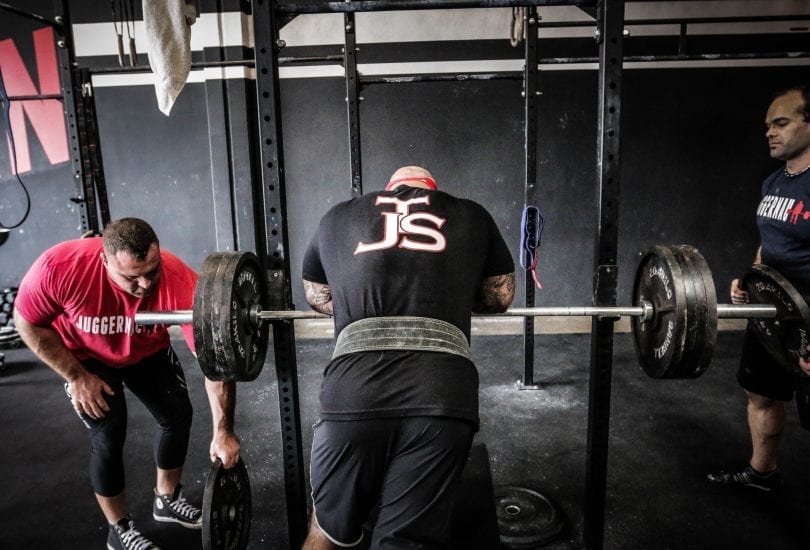Written by Thomas Lilley
What’s the best program for you? I am always perplexed by this idea that programming is some sort of magic trick. This notion that, if you find the right program for you, you will unlock a new level of strength and performance. Don’t get me wrong, programming is important. Really important. But it’s far from the be all and end all in strength improvement and performance. Rather, it’s a cog in the engine that drives the strength machine. An essential component of a working system.
Breaking down that system into its individual components, we find several key ingredients that form the recipe for strength, including:
- Technique development
- Programming
- Nutrition
- Rest/recovery
- Physical therapy, such as muscle release and mobility
The above factors work together towards overall strength improvement. Inconsistency in one area can be at the detriment of other areas, or the system as a whole. That recipe is several articles in and of itself. This piece will focus on programming.
I’ll keep this short and sweet by breaking it down into some key factors you should look for in programming:
Goal-based Specificity
Firstly, the program you use should be aimed towards achieving a specific goal. A powerlifting program should work towards getting you as strong as possible when doing 1 rep of a squat, bench press and deadlift. Every component of the program should serve a purpose towards that goal. You should be able to clearly justify why you are doing everything you are doing.
If you’re working with a coach for the program, they should be able to justify why you’re doing what you’re doing. Remember, you’re a customer, you’ve paid for a service – if you have questions or concerns, raise them. If the coach cannot adequately explain to you the reasoning behind the program, then they fall short of your expectations.
Exercise Selection
There are many ways to skin a cat (terrible saying, I know). Multiple exercises can work toward the same goal. The exercises in your program should work towards your goal for that training cycle. That means addressing any weaknesses or shortfalls that may let you down as you approach your goal. The exercises you use to address such shortfalls can be important. Again, this is about return on investment. It’s important to use the exercises that will yield the highest return.
An example here will help: Let’s say we have a lifter who loses back tightness in a deadlift, rounding through the lumbar, due to a weakness in stabilizing through the trunk. Their abs and obliques are strong, but their erectors are weak. The lifter is in a peaking cycle for a competition. We have 3 options here: Back extensions, good mornings or deficit deadlifts. All three work the lacking area. What do we choose?
Back extensions isolate the erectors, so are a good way to target the area directly.
Good mornings allow the creation of a rigid torso through a plane of hip flexion, which makes them more specific than extensions, and therefore potentially a better choice.
Deficit deadlifts, performed with a weight light enough to prevent the technical breakdown, allow the creation of a rigid torso, through an extended range of the exact movement where the breakdown occurs. This is the most specific of the three choices, and is therefore likely the best choice, especially given the limited time frame with an impending competition.
If you’re running things yourself, make sure you choose exercises that are best suited towards your goals. If you’re paying a coach, they should be able to explain the exercises you’ve been given and why.
Logical Progression
Nobodies’ goal is to get weaker. Whilst the formula for getting stronger isn’t necessarily exact, there are some defined rules. There are things we know about programming that lend themselves to strength improvement. We know what sort of reps we should be doing at what percentage and when. We understand the detriment of doing too much or too little. We know how to ramp up and deload for a peak, to prepare ourselves for a strength test or competition. These things are documented elsewhere in detail.
The point here is that, to get stronger, there must be a logical, structured progression across the period of a training cycle. If you’re programming for yourself, it would be best to have at least some idea of how to create that structure. If you’ve hired a coach, they should be able to explain it to you.
Now, what about individual considerations? Does every individual require a unique program, tailored specifically for him or her? Based on what we’ve covered here, the answer is – not really. Remember, programming is not a magic trick. Science has shown us what works and what doesn’t. There are always going to be individual differences regarding technique development, and the exercises to support that. Autoregulation within programming will always occur at different rates as well. Template programs, with a good backing and proven results are fantastic tools for lifters and coaches, when used correctly.
So, how is a template used correctly?
Well, if you’re working with a coach through the entire process, the individualization should come from technique adjustment, specific exercises to train individual weaknesses and guidance with autoregulation. If you’re using a template by yourself, wherever you got that template from should give instructions on where and why individualization and autoregulation can occur, or where it should not. Too often I see people playing the blame game, cursing coaches or programs for not working, to which delving deeper into the situation often reveals that important processes in the program were not adhered to.
Remember, the time and money you dedicate towards your training is important. Bet on the sure thing. If you’re unsure about programming, educated yourself or work with someone reliable and knowledgeable who can do the work for you.













